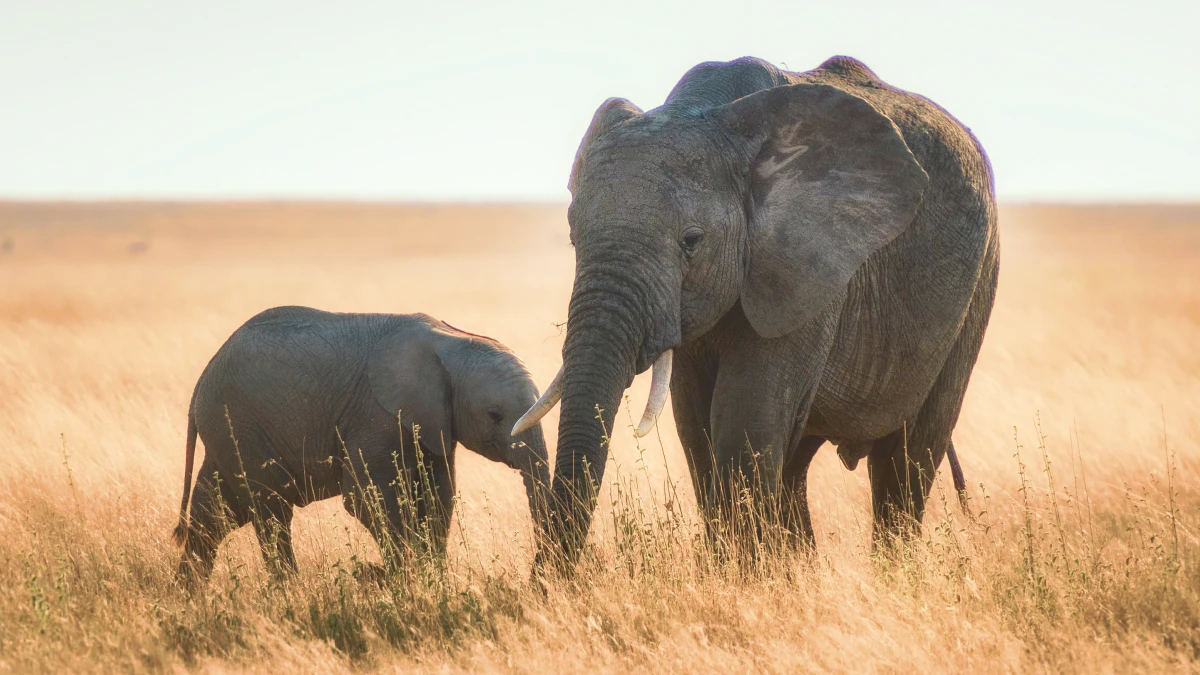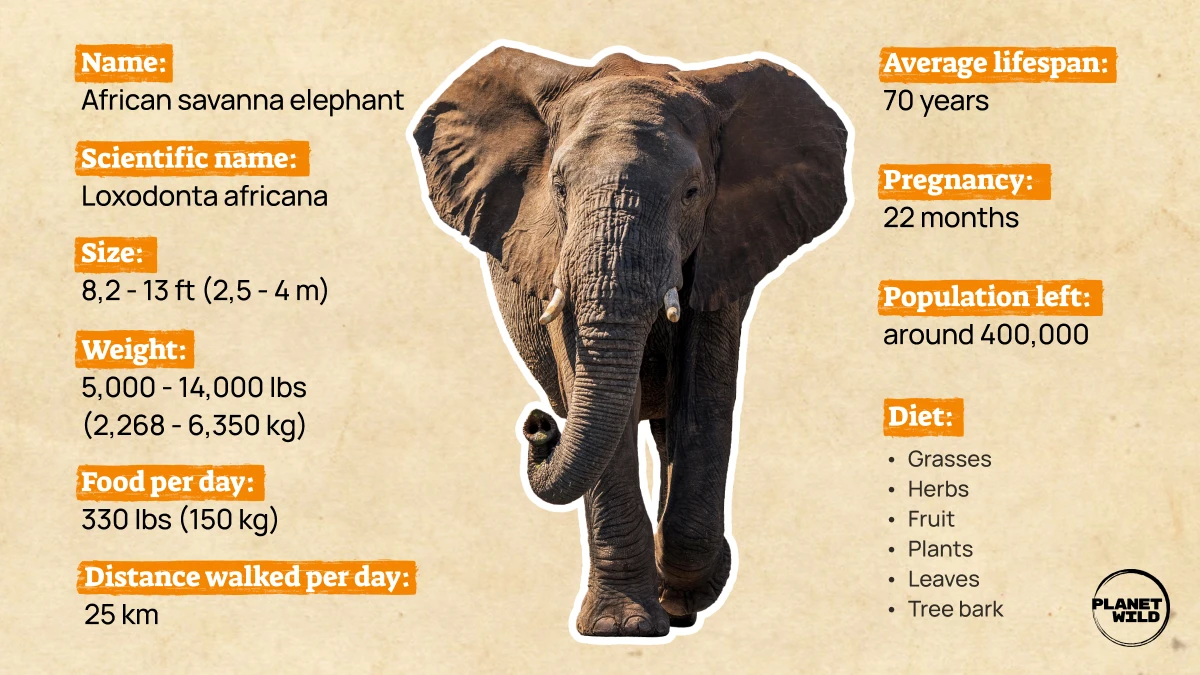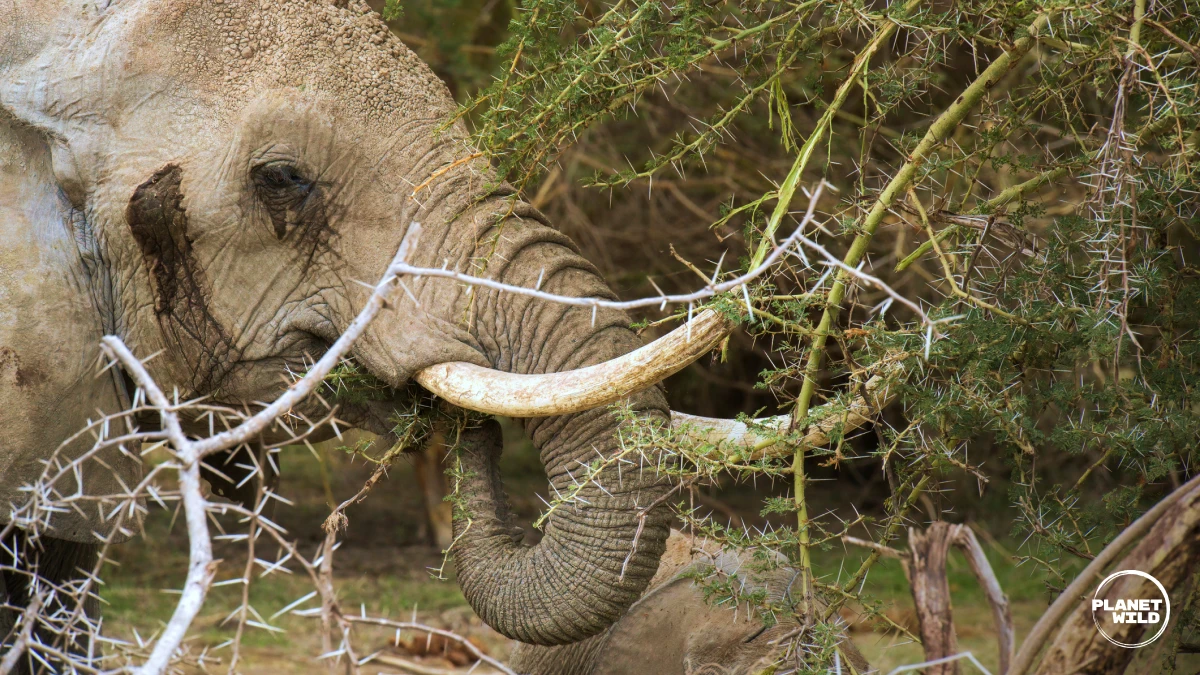Are elephants afraid of mice? Facts and myths about the African savanna elephant

Planet Wild team
Elephants are some of the planet’s most beloved mammals. These ‘gentle giants’ are key contributors to many ecosystems, predominantly in Asia and Africa. Unfortunately, these stunning animals are now looking at an uncertain future. Ivory poaching and habitat loss have driven elephant numbers to dwindle, with the African savanna elephant recently listed as endangered by the IUCN Red List.
African savanna elephant: Quick facts

In our latest blog post we will delve deep into the characteristics, habitat, diet and family structure of the African savanna elephant — and learn why it’s so important to protect this incredible species from harm and extinction.
Species: Types of African elephants
There are actually two types of African elephant: the savanna elephant (Loxodonta africana) — sometimes also called the African bush elephant — and the forest elephant (Loxodonta cyclotis). The main differences between these two species is mainly habitat, tusk shape and size. The savanna elephant is the bigger of the two, with an adult male weighing between 5000 to 14,000 lbs (2,268 to 6,350kg). A male forest elephant weighs around 10,000 lbs (4,536kg).
A savanna elephant’s tusks tend to be long, thick and curved outwards, while forest elephants have straighter and more downward-pointing tusks which are thinner and more parallel to the ground. Forest elephants also have smaller ears which help them easily manoeuvre through thick forest.
As the name suggests, forest elephants tend to stick to dense, tropical rainforest habitats. Savanna elephants prefer open grasslands and savanna, opting to move across vast open plains in search of food and water. Unlike their savanna counterparts, forest elephants are a critically endangered species.
Diet: What do African savanna elephants like to eat?
When it comes to diet, African elephants will munch almost anything they can get their trunks on. Elephants can travel up to 120 miles a day in search of food, water and shelter — but on average it’s more like 16 miles. They spend the majority of their day foraging for food, which is made up of grasses, leaves, fruit and tree bark — their favorite.
These herbivores need a huge amount of shrubland to keep them going, and will consume around 350 lbs (150 kilograms) of vegetation per day, per elephant! That’s around the weight of three queen-sized mattresses stacked together. All that eating, traveling and trampling helps clear large pathways through dense bush and shrubland which makes it easier for smaller animals to traverse the savannah. This is why they’re sometimes called ‘ecosystem engineers.’ Their dung is also crucial to biodiversity, as it helps distribute nutrients and seeds back into the earth so the bush can regenerate and thrive, supporting all life in the savanna.

Elephants are also experts in finding water, often using their tusks to dig deep holes in dry riverbeds and springs, releasing the water from deep underground. This process serves other savanna animals too; such as lions, zebras, giraffes, and warthogs; during the dry months. They are also known to supplement their fiber heavy diet with extra minerals from termite mounds and mineral licks.
Read More: An introduction to Mutualism: Nature’s partners in survival!
Habitat: Where do African elephants live?
The largest African savanna elephant populations can be found in southern and eastern African countries such as Tanzania, Botswana, Zimbabwe, Kenya, Namibia, Zambia, and South Africa, but reside in 23 countries in total throughout Africa. African elephants like to roam for miles across vast landscapes, which has put them into conflict with humans who are using their habitat for farming and settlements — and don’t want it trampled by a herd of elephants passing through! As a result, the elephants’ range has shrunk from three million square miles in 1979 to just over one million square miles in 2007.
African savanna elephants are perfectly evolved to survive and thrive in hot, arid conditions. They can be found in a number of habitats, ranging from deserts to open savannas, grasslands and woodland.
African elephant families: Who is in charge?
African elephants are highly intelligent and form close family bonds throughout their lives. Savanna elephants live in intricate social structures, forming tight-knit family groups led by a matriarch. These herds typically consist of other female relatives and their carves. The matriarch, usually the oldest and most experienced female (also calleds cows), plays a crucial role in decision-making and guiding the herd. The whole group works together to raise and protect the young, and search for food and water.

Male elephants (bulls), on the other hand, are solitary animals that either traverse the savanna alone or travel in smaller bachelor herds. The male elephants gradually separate from the larger herd as they become adults, and learn key navigation and survival skills from the older bulls who have spent decades maintaining and passing along their knowledge.
Heartbreakingly, old bull elephant tusks are particularly valuable to poachers. The loss of these old bulls means that a lifetime of vital elephant knowledge is lost, impacting the survival of the younger males.
Read more: Meet the Little Owl: Europe’s most adorable bird facing an uncertain future
Mythbusting: Popular myths about the African elephant
Myth: Elephants are afraid of mice
Contrary to popular belief, elephants are not exactly afraid of mice. The myth is likely a misunderstanding about how any animal would react to something scuttling around its feet. So yes, an elephant may be startled by a mouse, but not exactly terrified.
Having said this, these giant animals are afraid of one thing: bees. Elephant hide is tough and thick, but bees are small enough to reach the sensitive areas around their eyes, trunks and mouth. Elephants will often flap their ears, stir up dust, make noise, or turn and flee in the presence of bees. Baby elephants have thinner skin which means that accidental collision with a bee hive can cause some serious damage!
Myth: Elephants go to elephant graveyards to die
Elephant graveyards are, according to legend, a place where old elephants direct themselves to die, laying down to be buried amongst their ancestors. However, there is no scientific evidence that these so-called ‘elephant graveyards’ exist. There are a couple of theories as to where this myth came from, including groups of elephant bones being discovered together. Another theory is that poachers killed groups of elephants in one location, taking their tusks away to be sold.

While it’s true there isn’t such a thing as an elephant graveyard, there is evidence that African elephants mourn their loved ones deeply when they die. They may return to their final resting place over the years, displaying a level of empathy close to ours.
Myth: Elephants drink through their trunks
It would be strange to imagine any land mammal drinking through its nose, and the same can be said for elephants! African elephants do use their nose to drink, however, but they suck water halfway up their trunks and squirt it into their mouths. In fact, it takes an African elephant only one second to suck three liters into its trunk!
Myth: Elephants love peanuts
When it comes to peanuts, elephants aren’t really a big fan. They are herbivores who prefer to munch on grasses, fruits, leaves, tree bark and an abundance of other foliage found in the bush. This myth is likely to have originated in the 19th century when elephants were an attraction in circuses and zoos. Onlookers could pay to feed them, and a bag of peanuts was a simple and affordable way to do so.
What are the biggest threats facing the African elephant right now?
Some elephant populations have plummeted almost 90% in the last 50 years. Throughout eastern and southern Africa, the outlook isn’t much better. There are only around 400,000 African elephants left in the wild, a big drop from the estimated 1.4 million African elephants that were alive in 1970. So what has caused the huge decline of elephants in Africa?
Poaching and the ivory trade
Ivory is one of the world’s most controlled and expensive materials. It is used as a status symbol, in art and in traditional medicine across a number of cultures. Because of its high value and desirability, a black market for ivory fuels the illegal trade and poaching — despite an international ban on its acquisition and unregulated sale. Poaching for ivory remains a significant threat to elephants in Asia and Africa. It’s not just elephants either — the black rhino has nearly been hunted to extinction for its valuable ivory horn.
Human-Elephant conflict
When elephants feel threatened or collide with human settlements, it can result in some pretty unhappy situations. Human-elephant conflict (HEC) manifests as crop raiding; when elephants eat and trample farms; or casualties and deaths as humans get too close, triggering their defensive behaviors. These conflicts not only affect people's safety and elephants’ survival, but also the health of the ecosystem and rural communities.
Check out ways communities are combatting this problem in our latest Planet Wild mission!
Habitat loss
As we mentioned, elephants need a lot of space to roam. Herds roam for miles and miles across borders and plains, but human settlements, farms and communities have shrunk their environment significantly. In many countries like South Africa and Tanzania, national parks and private game reserves help keep the elephant’s safe from humans and poachers, but also restrict their movement. However, despite the best efforts of these protected spaces, illegal poaching is still a big problem.
Read more: What are Europe’s most endangered predators?
5 weird and wonderful facts about African elephants
- African savanna elephants can be pretty dangerous!
While they look slow, chunky and cute, African savanna elephants can be really dangerous when threatened or in heat. Lions, leopards and other carnivores are definitely a threat, but elephants are big and can run much faster than us — up to 40mph in some cases. Female elephants can become particularly aggressive if they feel their baby is under threat.
- They use little earthquakes to communicate
An African elephant’s trampling is so earth-shattering that it creates underground sound waves that can travel for miles and miles. Elephants use these mini-earthquakes to send seismic signals to each other across the savanna, alerting others of their arrival. Their large feet are actually very sensitive, and able to pick up these vibrations across great distances.
- They use their trunks for more than breathing

Elephants use their trunks for many things. They like to touch or rub them together as a greeting to other elephants in the herd, or even a sign of reassurance. They also use them to spray cool mud over their bodies to help them cool down on warm days, and even use their trunks to play games with each other. Most incredibly, an elephant’s trunk is so dexterous that they can even use tools (rocks, twigs, etc) to create makeshift fly swats or move bushes out of their way.
- Elephants have an incredible memory
“An elephant never forgets” is a famous saying that while not being entirely true, has a fair amount of truth to it. Older elephants, like the herd’s matriarch, are able to recall the faces of their friends (and enemies), as well as map and remember vast landscapes, leading the herd to key water sources. This is because their temporal lobe — the part of the brain that’s responsible for memory — has evolved to be larger and denser, allowing it to maintain key information important for survival.
- They have a “sixth toe”
Elephants have a unique skeletal structure that includes a false sixth toe, also known as a "prepollex," on their front feet. This extra toe is located above the true hooves to help the elephant support its massive weight as it moves across the savanna.
About Planet Wild
Planet Wild is committed to rewilding the planet through monthly missions that work directly with grassroots organizations dedicated to fighting the biodiversity crisis. When you become a Planet Wild member, your contribution will directly fund innovative and exciting projects all over the world, so you can make a difference from home. Learn more about what we do here.